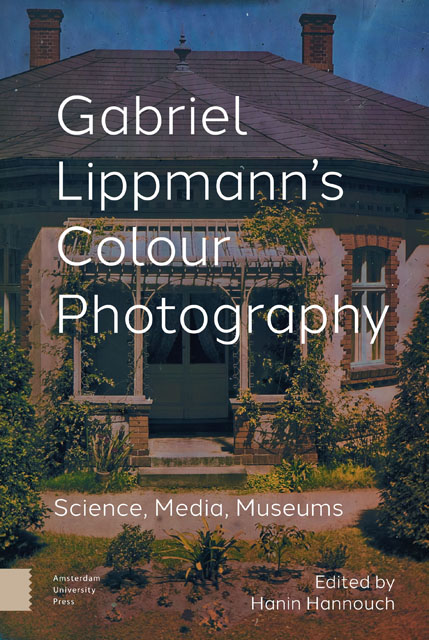Book contents
- Frontmatter
- Table of contents
- Gabriel Lippmann’s Colour Photography: A Critical Introduction
- Part I The Science of Colour Photography and the Colour Photography of Science
- Part II Media History, Aesthetics, and Culture
- Part III Contemporary Reception and Future Trajectories
- Afterword: Building Bridges over Standing Waves
- Index
Afterword: Building Bridges over Standing Waves
Published online by Cambridge University Press: 16 November 2022
- Frontmatter
- Table of contents
- Gabriel Lippmann’s Colour Photography: A Critical Introduction
- Part I The Science of Colour Photography and the Colour Photography of Science
- Part II Media History, Aesthetics, and Culture
- Part III Contemporary Reception and Future Trajectories
- Afterword: Building Bridges over Standing Waves
- Index
Summary
Abstract
This afterword examines how Gabriel Lippmann's work can generate interdisciplinary viewpoints. Starting with Lippmann's cooperation with the Lumiere brothers and their reception in the artistic press, it then examines interferential photography's position in the history of the medium and asks questions on how it can be renewed through interpretations from a cultural or media archaeology point of view. Last, it demonstrates how research on the Lippmann process is being renewed thanks to recent interest in museum collections, digitisation projects and upcoming exhibitions.
Keywords: interferential colour photography, Lumiere brothers, aesthetics, art history, museum collections
On Monday February 2, 1891, Gabriel Lippmann, a member of the Physics section since 1886, presented a communication to his colleagues at the Academie des Sciences de Paris that could be seen as a wager: “I have decided to obtain a coloured image of the spectrum on a photographic plate in such a way that the image will remain permanently fixed and can be observed in full daylight without fading over time.” (Lippmann 1891, 274).
While Frederik Eugene Ives's composite heliochromies drew attention to the reproduction of colours by additive colour synthesis, the French physicist sought to capture a colour image “directly.” Immediately and unanimously acclaimed for its elegance, interferential photography seemed to accomplish the desire to “paint with light” (Becquerel 1868, 218). Following work begun in 1848 by Edmond Becquerel then Niépce de Saint-Victor and the colour synthesis “solutions” presented by Louis Ducos du Hauron and Charles Cros in 1869 (Cros 1869, du Hauron 1869), Gabriel Lippmann proposed an entirely new approach, drawing on the wave-based nature of light. He broke with existing paradigms, opening an entirely new field of research into colour photography that was mainly physical.
Unfortunately, the remarkable scientific value of his research could not compensate for the complexity of his method and the irregular nature of its results. The process never really got beyond the experimental stage and was only ever employed by a handful of experienced users around the world. While the process undoubtedly solved the hitherto unachievable goal of colour permanence, interferential photography recorded colour but “could only create it on a single image” (du Hauron 1897, 474). Comparing his brother's three-colour method to Lippmann’s, Alcide Ducos du Hauron stated: “While interferential colour photography is admirable, should we criticise the fact that it doesn't have the gift to reproduce?” (du Hauron 1897, 87).
- Type
- Chapter
- Information
- Gabriel Lippmann's Colour PhotographyScience, Media, Museums, pp. 297 - 304Publisher: Amsterdam University PressPrint publication year: 2022



